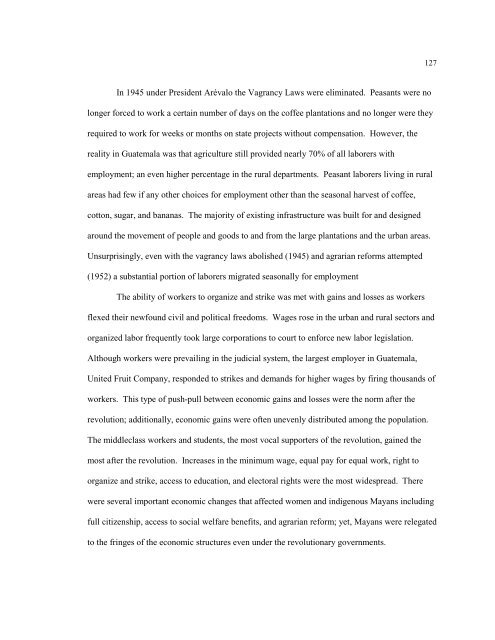Complete Thesis_double spaced abstract.pdf
Complete Thesis_double spaced abstract.pdf
Complete Thesis_double spaced abstract.pdf
Create successful ePaper yourself
Turn your PDF publications into a flip-book with our unique Google optimized e-Paper software.
In 1945 under President Arévalo the Vagrancy Laws were eliminated. Peasants were no<br />
longer forced to work a certain number of days on the coffee plantations and no longer were they<br />
required to work for weeks or months on state projects without compensation. However, the<br />
reality in Guatemala was that agriculture still provided nearly 70% of all laborers with<br />
employment; an even higher percentage in the rural departments. Peasant laborers living in rural<br />
areas had few if any other choices for employment other than the seasonal harvest of coffee,<br />
cotton, sugar, and bananas. The majority of existing infrastructure was built for and designed<br />
around the movement of people and goods to and from the large plantations and the urban areas.<br />
Unsurprisingly, even with the vagrancy laws abolished (1945) and agrarian reforms attempted<br />
(1952) a substantial portion of laborers migrated seasonally for employment<br />
The ability of workers to organize and strike was met with gains and losses as workers<br />
flexed their newfound civil and political freedoms. Wages rose in the urban and rural sectors and<br />
organized labor frequently took large corporations to court to enforce new labor legislation.<br />
Although workers were prevailing in the judicial system, the largest employer in Guatemala,<br />
United Fruit Company, responded to strikes and demands for higher wages by firing thousands of<br />
workers. This type of push-pull between economic gains and losses were the norm after the<br />
revolution; additionally, economic gains were often unevenly distributed among the population.<br />
The middleclass workers and students, the most vocal supporters of the revolution, gained the<br />
most after the revolution. Increases in the minimum wage, equal pay for equal work, right to<br />
organize and strike, access to education, and electoral rights were the most widespread. There<br />
were several important economic changes that affected women and indigenous Mayans including<br />
full citizenship, access to social welfare benefits, and agrarian reform; yet, Mayans were relegated<br />
to the fringes of the economic structures even under the revolutionary governments.<br />
127














![Completed Thesis to Grad Studies[Final3].pdf](https://img.yumpu.com/17538645/1/190x245/completed-thesis-to-grad-studiesfinal3pdf.jpg?quality=85)
